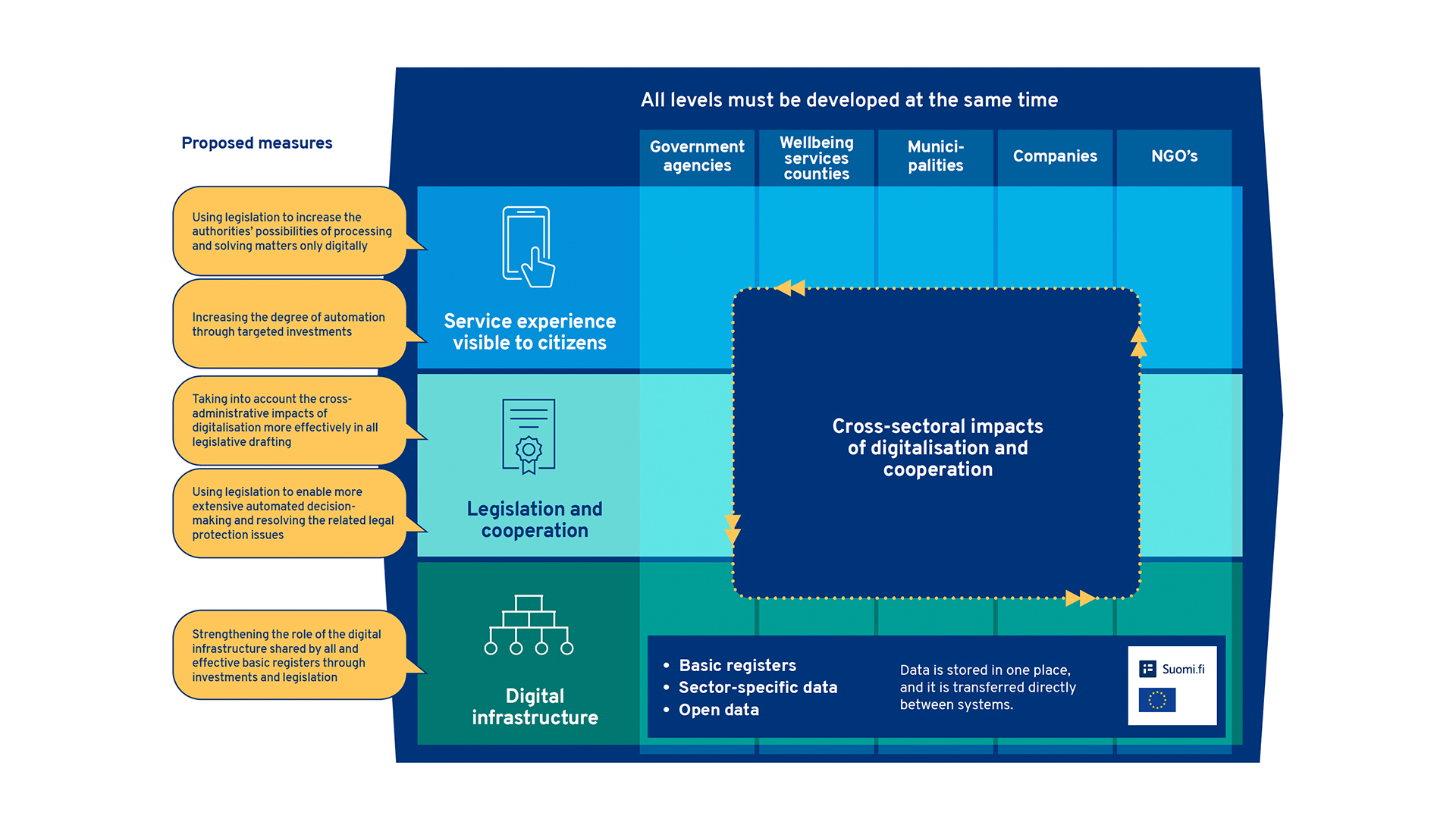Digihumaus-report 2022:
Four scenarios for the future of digitalisation
In the last two years, the whole world has experienced two massive crises, both of which we are still living in. The Russian attack in Ukraine has irreversibly changed the world's safety balance, the consequences of which we do not yet know – but it is certain that there will be long-term repercussions.
The coronavirus pandemic has also highlighted some worrying developments. As a result of the spreading of rumours about coronavirus, conspiracy theories and disinformation online from one continent to another, polarisation and instability have increased, and it has become more difficult to solve other global challenges as well. In international comparisons, Finland has had an exceptionally strong trust in society. Recently, there has been greater scepticism about expert knowledge and public authorities also in Finland.
In the 2021 Digihumaus report, we discussed the impacts of the coronavirus pandemic on societal trends in more detail. In this year’s report, we examine four possible future scenarios as we are moving towards the 2030s. We established trust and cooperation as the perspectives from which to examine the scenarios. The analysis of the scenarios presented in this report has been formed on the basis of these perspectives. Trust is the most important capital in society and the digital environment. Working together opens up possibilities: when should we work together, when do we need distance and independence.
"Trust is the most important capital in society and the digital environment."
The scenarios until 2030 help anticipate future developments, direct the development of digitalisation, and build digital public services to support a smoother everyday life. The scenarios are not forecasts of the future, but possible and alternative future visions and descriptions of the operating environment. Instead of one certain truth, the right steps can usually be found between the different scenarios: all scenarios include features that will be realised.
Global governance of digitalisation is increasingly divided between democratic, oligarchical and authoritarian regimes
The pressure to reduce dependence on actors outside the EU has led the Nordic and Baltic countries to intensify digital integration and accelerate EU cooperation on value-based digitalisation, smooth everyday life and digital sovereignty. Both national and international cooperation will continue to play a key role in accelerating digital transitions in all sectors.
In the global digital competition, a more efficient organisation of the digital market within the EU and the innovation capacity of companies can help European digitalisation to rise. It is important to restrict the power of global digital giants in the platform economy by developing the regulations and European taxation, but at the same time, more unicorns are needed in Europe. As smooth an interoperability of services and data as possible should be the cornerstone of European digitalisation regulations, while also building trust in the correct and acceptable use of data.
Services and activities must be developed on several levels
Digitalisation mainly refers to a change in the operating methods, not just technological development. In a society that strives for interoperability and fluency, it is not possible to focus solely on developing individual services and specific legislation concerning them. At the same time, it is important to develop the legislation in general, alongside operating methods and the underlying digital infrastructure.
This development should take place simultaneously and in network cooperation. This will enable interoperability and also bring cost-effectiveness to the visible aspect of the service. In all digitalisation investments, funding should therefore be allocated to the strengthening of the common base. This will keep Finland at the top of the global digitalisation competition and further strengthen its position in it.
Click the picture to see it in larger scale.
Proposed measures for all scenarios:
Strengthening the role of the digital infrastructure shared by all and effective basic registers through investments and legislation.
Taking into account the cross-administrative impacts of digitalisation more effectively in all legislative drafting.
Increasing the degree of automation through targeted investments.
Using legislation to enable more extensive automated decision-making and resolving the related legal protection issues.
Using legislation to increase the authorities’ possibilities of processing and solving matters only digitally.
Four scenarios for the future of digitalisation
Click the picture to see it in larger scale.
The Finland of platforms
Finland is a society based on trust in which the actors engage in goal-oriented cooperation

The digitalisation of public administration is guided both nationally and in the EU by shared objectives, a vision and a situational picture of a fair and sustainable digital green transition. In developing public services, the aim is to provide easy services that understand the clients’ needs. Proactive, compatible and needs-based services operate through shared public administration platforms. Finnish digital exports have increased.
The services are built ethically and they ensure the protection of personal data so that the authorities and companies do not have a comprehensive view of all information related to an individual. Digital services are reliable and easy to use. They are the primary service channels. This makes it possible for administrative experts to serve those who are unable to use digital services. However, over-confidence can cause speed blindness, which makes it more difficult to scale services and prepare for digital threats.
Possibilities
Increasing trust through digitalisation
Making Finnish digitalisation an export product
Bridging the sustainability gap
International cooperation accelerates digital transitions in all sectors
Risks
Speed blindness and overservice lead to a lack of resources
Risks of digitalisation at EU level when, for example, information exchange becomes automated
The EU regulates itself out of the markets
Limited ecological resources
Digital fatigue
Proposed measures if this scenario becomes emphasised:
Strengthening basic funding for actors in the society based on trust in proportion to more controlled project funding.
Strengthening citizens’ digital skills and enabling their self-motivated transition to digital services by increasing investments in digital support.
The planet of local solutions
The planet of local solutions is a society based on trust where services are nonadjacent but close to people

In the management of digitalisation, local and independently implemented solutions are emphasised both in Finland and internationally. Regional solutions are considered reliable and human-oriented, as the organisations producing them have the best situational picture of the changing operating environment, customer base and its diverse needs. Local and personal solutions guarantee high-quality and successful services for their users.
International competition speeds up the development, but the digital gaps between regions will increase as the benefits of local solutions are unevenly distributed. In some places, you can get better personal services than elsewhere. This may lead to overlaps, waste of resources and a poor service flow. The costs of digital security are high, even if digital independence succeeds in limiting the impact of possible cyber attacks.
Possibilities
Good services for your own customer segment
Local solutions bring efficiency through competition
Tailored digital services
Risks
Segregation
Regional inequalities in the quality of solutions
Inefficient use of limited resources
Failure to see the overall picture
Silos and fragmentation
Proposed measures if this scenario becomes emphasised:
Investing more in the adaptability and flexibility of shared platforms, which makes it possible to build cost-effectively tailored services on them.
Increasing strategic guidance and developing control structures in order to have shared objectives and a situational picture in the distributed service production.
The worksite of digital gaps
The worksite of digital gaps is an administration-oriented society where services are created through co-operation between actors

Public administration is under pressure to resolve the sustainability gap and other complex administrative problems as effectively as possible. This leads to the development of digital services based on administrative requirements. The development is fundamentally not client- or human-oriented. Therefore, citizens do not have enough opportunities to influence and participate in the development of digitalisation. Trust is low in the data economy and digital environments, and many people unnecessarily avoid even the relevant digital services.
The strained public finances seek efficiency by increasing investments and joint solutions that exceed the organisational structures. The aim is to increase e-services by making them more obligatory. The reform of the operating culture and legislation of public administration is slow, and Finland is starting to lose its leading position in the use of digitalisation.
Possibilities
Obligations increase the utilisation rate
Efficient use of resources
The scenario can serve as a milestone on the path to a different world
Risks
Increased failure demand
The risk of exclusion and increased distrust caused by the compulsory use of digital services
Monitoring and control, loss of privacy
Proposed measures if this scenario becomes emphasised:
Curbing the growth of distrust by investing extensively in service design and a clear administrative language.
Strengthening cooperation between the public and private sector.
The wilderness of lonely individuals
In the wilderness of lonely individuals, the renewal of services depends on the competence of strong local actors

In the fight against climate change, cyber threats and the adverse effects of digitalisation, people do not trust that others will also play their part in the name of collective responsibility. Digital public services are developed in an uncertain and difficult operating environment. Administration will become overly cautious, and the ability to reform will depend on the competence of individual actors. There is great variation in the ease of use, quality, security and reliability of different services, which increases polarisation.
European cooperation is weakening. The continent is left behind by digital giants and other international actors, as national borders and customs are thresholds too high to cross. At the same time, the decision-making possibilities of individual EU countries will be strengthened nationally, which may accelerate the development of national digitalisation, albeit at the expense of interoperability.
Possibilities
Towards digital self-sufficiency
Preparedness and continuity management gain attention, and non-digital alternatives for processes may be considered
Stable services and interfaces: easier to learn and develop on them
There is a demand for responsible solutions that increase trust
Risks
Segregation between the public and private sectors
Monopolies, legacy and compatibility issues
Polarisation of well-being
Algorithmic discrimination
Proposed measures if this scenario becomes emphasised:
Combining services into larger entities, which brings cost-effectiveness.
Increasing bilateral cooperation both nationally and internationally.
We have involved the personnel, management, stakeholders and external experts of the Digital and Population Data Services Agency in the scenario work. We thank everyone for the time they have contributed to the work, and for the ideas that have enriched our analysis and process. The promotion of digitalisation is a joint effort, and for this reason, we need everyone’s voice to be heard. Read the scenarios and share your thoughts, for example, in social media with the hashtag #SujuvaSuomi!
Sources
- Aitonurmi, Joonas, Reivo, Juho & Jokela, Eetu (2021): Ennakoiva digitaalisen ympäristön riskienhallinta. Futura 4/2021, 45–51.
- Andersen, Ming Unn (2020): Playing make believe in the Finnish Digital Agency. Exploring socio-political implications in digital public sector through Speculative Design and Live Action Roleplay. Master’s thesis, Collaborative and Industrial Design. Aalto University School of Arts, Design and Architecture.
- Bodrožić, Zlatko & Adler, Paul S (2021): Alternative Futures for the Digital Transformation: A Macro-Level Schumpeterian Perspective. Organization Science, 30.12.2021. https://doi.org/10.1287/orsc.2021.1558
- DVV (2021): Digihumaus 2021: Näkökulmia koronapandemian jälkeiseen digiloikkaan. Digi- ja väestötietovirasto.
- DVV (2020): Digihumaus 2020: Näkökulmia 2020-luvulle digitalisaation hyödyntämiseksi yhteiskunnassa. Digi- ja väestötietovirasto.
- Eaves, David & Lombardo, Lauren (2020): 2020 State of Digital Transformation. Ash Center, Harvard Kennedy School.
- Julkisen hallinnon strategia (2021).
- Lindgren, Jaakko, Roope Mokka, Aleksi Neuvonen, Antti Toponen, Linda Liukas, ja Iida Sofia Hirvonen (2019). Digitalisaatio: Murroksen Koko Kuva. Tammi.
- Mazzucato, Mariana (2015): The Entrepreneurial State: Debunking Public Vs. Private Sector Myths. PublicAffairs.
- Neittaanmäki, Pekka, Martti Lehto & Matti Savonen (2021): Yhteiskunnan digimurros. Jyväskylän yliopiston IT-tiedekunto. Yliopistopaino, Jyväskylä.
- Olsson, Thomas (2022): Kestävämpi tulevaisuus edellyttää kestävämpää IT:n suunnittelua. Luento 20.1.2022. Tieteiden yö 2022: Digitaalinen teknologia ja kestävä tulevaisuus.
- World Economic Forum (2021): The Global Risk Report 2021.
- Zuboff, Shoshana (2019): The Age of Surveillance Capitalism: the Fight for a Human Future at the New Frontier of Power. PublicAffairs.


